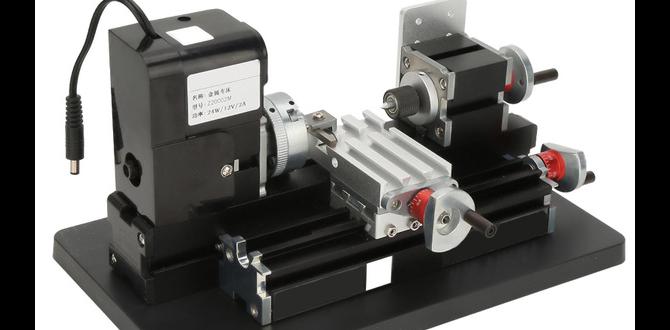Quick Summary: Facing brass chatter on your mill? A 1/8 inch carbide end mill, especially one with specific fluting and a standard length, is your best bet. We’ll show you how to pick the right one and use it to get smooth, chatter-free brass cuts every time. Get ready for professional results, even in your home workshop!
Hey there, fellow makers! Daniel Bates from Lathe Hub here. Ever tried to mill some nice, shiny brass, only to end up with a surface that looks like a rumpled bedsheet? That vibrating, chattering mess is super frustrating, especially when you’re just starting out. It can make you think the problem is with your machine, or even you! But don’t worry, often, the solution is much simpler. It’s usually down to the right tool for the job. Today, we’re diving deep into a specific, incredibly useful tool: the 1/8 inch carbide end mill. This little powerhouse is often the secret weapon for tackling brass chatter. We’re going to break down exactly why it works, how to choose the perfect one, and the best way to use it to achieve those smooth, professional finishes you’re after. Stick with me, and you’ll be milling brass like a pro in no time.
Why Does Brass Chatter Happen?
Chatter, that annoying vibration that shows up as a rough, wavy surface on your workpiece, is a common headache when milling. It happens when the cutting tool doesn’t have a consistent bite into the material. Think of it like a skipping record – the needle jumps out of the groove. In milling, if the tool digs in too hard, then lifts slightly, then digs in again, you get those tell-tale ridges and fuzziness on your part. This is especially true with softer metals like brass, which can be a bit gummy. The tool can catch and pull, leading to vibration.
Several factors can contribute to chatter:
- Tooling: A dull or damaged end mill, or one that’s not suited for the material.
- Machine Rigidity: A wobbly machine, loose spindle, or worn ways can easily lead to vibration.
- Cutting Parameters: Speeds and feeds that are too high or too low, or incorrect depth of cut.
- Workholding: A workpiece that isn’t held securely is a prime suspect for vibration.
- Material Properties: Softer metals like brass are more prone to tearing and vibration.
For beginners, it’s easy to get overwhelmed trying to fix everything at once. That’s why focusing on a critical component like the end mill makes so much sense.
The 1/8 Inch Carbide End Mill: Your Brass Best Friend
So, why is a 1/8 inch carbide end mill often the hero of the story for brass? Let’s break it down.
What is an End Mill?
An end mill is a type of milling cutter. Unlike a drill bit, which drills straight down into material, an end mill can cut sideways as well as downwards. They have cutting edges along their sides and at the tip. This makes them incredibly versatile for tasks like slotting, profiling, facing, and creating pockets in your workpiece.
Why Carbide?
Carbide, specifically tungsten carbide, is an extremely hard and wear-resistant material. Tools made from carbide can cut much harder materials and retain their sharpness longer than tools made from High-Speed Steel (HSS). For milling, especially at higher speeds or with tougher materials, carbide offers superior performance and tool life. This means fewer tool changes and more consistent cutting, which is crucial for reducing chatter.
Why 1/8 Inch?
The 1/8 inch size is particularly useful for several reasons when milling brass:
- Detail Work: Small end mills are perfect for intricate details, small radii, and fine features often found in jewelry, models, or small mechanical parts made from brass.
- Reduced Cutting Forces: A smaller diameter tool generally requires less force to cut. This means less stress on the tool, the machine, and the workpiece, all of which can help dampen vibrations.
- Chip Load Management: With a smaller diameter, it’s easier to achieve a desirable chip load (the thickness of the material being removed by each cutting edge) at reasonable spindle speeds and feed rates, especially on smaller or hobbyist milling machines. This controlled chip formation is key to smooth cutting.
The Chatter-Fighting Combination
When you combine the strength and wear resistance of carbide with the small, manageable size of a 1/8 inch diameter, you get a tool that’s less prone to deflection and vibration. It can maintain a more consistent engagement with the brass. Combined with proper machining techniques, this significantly reduces the chances of chatter. This is especially true for end mills designed with specific flute counts and geometries for softer metals like brass.
Choosing the Right 1/8 Inch Carbide End Mill for Brass
Not all 1/8 inch carbide end mills are created equal, especially when it comes to corralling brass chatter. Here are the key features to look for:
Flute Count: The Sweet Spot for Brass
The flutes are the helical grooves on the end mill. They carry away chips and provide cutting edges. For machining softer, “gummier” metals like brass, the flute count is critical.
- 2 Flutes: These are often the go-to for softer metals like aluminum and brass. The fewer flutes mean larger chip gullets (the space between flutes). This allows them to efficiently clear chips, preventing the build-up of material that can cause clogging and chatter. They also provide a good balance between cutting action and chip evacuation.
- 3 Flutes: Can sometimes work for brass, especially if the brass is a harder alloy or if you’re aiming for a smoother finish with lighter cuts. However, they have smaller chip gullets than 2-flute mills, which can be problematic with softer brass.
- 4 Flutes (or more): Generally NOT recommended for milling soft brass. The chip gullets are too small, leading to chip packing, tool breakage, and significant chatter. They are better suited for harder steels and cast iron.
Recommendation for Brass: Start with a 2-flute carbide end mill. If you find you need a smoother finish and your machine can handle it, a 3-flute designed specifically for aluminum/brass might be an option, but the 2-flute is generally the safer bet for chatter-free results.
Coating: Does it Help?
End mills can come with various coatings. While some coatings are designed to reduce friction and increase wear resistance, for brass, the basic uncoated carbide or a standard bright finish is often perfectly adequate. Coatings like TiN (Titanium Nitride) or TiAlN (Titanium Aluminum Nitride) are primarily beneficial for high-temperature operations or cutting harder metals. For brass, they might not provide a significant advantage in preventing chatter and can sometimes add unnecessary cost.
End Mill Geometry: Straight vs. Ball vs. Corner Radius
The shape of the cutting tip matters:
- Flat/Square End Mills: These have a flat tip and are used for creating slots, pockets, and shoulders with square corners. For general brass milling, these are very common.
- Ball End Mills: These have a rounded tip, creating a radiused bottom in pockets and used for 3D contouring.
- Corner Radius End Mills: These are a hybrid, with a flat bottom but with a slight radius at the corners where the side cuts meet the end. This radius helps to strengthen the corners, reducing the chance of chipping, and can lead to a smoother finish than a sharp square corner. For reducing chatter, a slight corner radius can sometimes be beneficial as it doesn’t create as sharp a stress concentration at the deepest point of cut.
Recommendation for Brass: A standard 2-flute flat end mill is a great starting point. If you’re looking for a subtle improvement in finish and durability, a 2-flute with a small corner radius (e.g., 0.010″ or 0.020″) can also be very effective.
Shank Type: Standard vs. Tool Holder Compatibility
Most 1/8 inch end mills will have a 1/8 inch shank. Ensure the shank is straight and clean. For CNC machines, ensure the shank diameter matches your collet system. For manual machines, a straight shank is standard.
Length: Standard vs. Extended
For minimizing vibration and chatter, a standard length 1/8 inch end mill is generally preferred. Extended length end mills have more flute exposure, making them more prone to deflection and vibration, which directly contributes to chatter. Stick to standard lengths unless you have a very specific reach requirement.
Material of Brass
Brass isn’t just one material; it’s an alloy family. Common types include:
- Cartridge Brass (C260): A very common and relatively soft brass, easy to machine but prone to gummy behavior.
- Free-Machining Brass (C360): Contains lead, making it even easier to machine and chip. It’s the go-to for automated screw machines and general brass machining. Can be gummy if not cut correctly, so chatter is a concern.
- Naval Brass (C464): A bit harder, with better strength.
For the “gummy” types like C360, using a 2-flute end mill and focusing on proper chip evacuation is paramount. A good resource for understanding metal properties is from organizations like the Copper Development Association.
Essential Tools and Setup for Chatter-Free Brass Milling
Having the right end mill is only part of the battle. Here’s what else you’ll need and how to set it up for success:
Tools You’ll Need:
- 1/8 inch 2-Flute Carbide End Mill: Specifically designed for aluminum/brass if possible.
- Collet Chuck or Collets: A good quality ER collet chuck or matching collets for your mill spindle. Ensure they are clean and provide a tight grip on the end mill shank.
- Workholding Fixture: Vise, clamps, or a fixture to securely hold your brass workpiece.
- Cutting Fluid or Lubricant: Essential for brass to prevent material welding to the tool and to help with chip evacuation. See the section below for recommendations.
- Deburring Tool or File: To clean up edges after machining.
- Measuring Tools: Calipers, a ruler, or a dial indicator for setting up your workpiece and checking dimensions.
- Safety Glasses: Always!
- Hearing Protection: Recommended, especially during longer operations.
Setting Up Your Machine and Workpiece:
- Secure the Workpiece: Clamp your brass block firmly in a vise or fixture. Ensure it’s only supported on solid surfaces, not allowing any rocking or lifting. Even slight movement here will cause chatter.
- Install the End Mill: Insert the 1/8 inch carbide end mill into a clean collet. Tighten the collet securely in the spindle. Make sure the end mill is seated properly and runout is minimal (check with a dial indicator if possible). For manual mills, ensure the spindle lock is engaged if applicable.
- Apply Lubricant: Brass benefits greatly from lubrication. You can use a mist coolant system, a flood coolant system, or even a dedicated tapping fluid or a light machine oil applied manually as you cut. For hobbyists, a spray can of cutting fluid designed for aluminum or brass works well. This helps prevent the brass from welding to the flutes and cools the cutting edge.
- Set Z-Zero: Carefully bring the tip of the end mill down to the surface of your workpiece and set your Z-axis zero. This is crucial for accurate depth control.
Mastering Cutting Parameters for Brass
Getting the speed and feed right is probably the most critical step after choosing the correct tool. For brass and a 1/8 inch carbide end mill, here are some starting points:
Surface Speed (SFM) and Spindle RPM
Surface speed is the speed at which the cutting edge moves through the material. Different materials and tool types recommend different SFM. For carbide end mills in brass:
- Recommended SFM: 200 – 400 SFM (Surface Feet per Minute)
To convert SFM to Spindle RPM (Revolutions Per Minute), you use the formula:
RPM = (SFM × 12) / (π × Diameter)
Let’s calculate for a 1/8 inch (0.125 inch) diameter end mill:
- Using the lower end (200 SFM):
RPM = (200 × 12) / (3.14159 × 0.125) ≈ 6110 RPM - Using the higher end (400 SFM):
RPM = (400 × 12) / (3.14159 × 0.125) ≈ 12217 RPM
Practical Advice: Most hobbyist milling machines might not reach these very high RPMs consistently, especially with a rigid tool. Start at the higher end of what your machine can reliably achieve. If you hear chatter, you might need to back off the speed slightly or focus more on feed rate and chip load.
Feed Rate and Chip Load
Feed rate is how fast the tool moves through the material. Chip load is the thickness of the material removed by each cutting edge per revolution. A good chip load is essential for efficient cutting and preventing chatter. Too small a chip load, and the tool rubs instead of cuts, leading to heat and chatter. Too large, and the tool might overload or break.
- Recommended Chip Load for 1/8″ 2-Flute Carbide in Brass: 0.001″ – 0.003″ per tooth.
To calculate the Feed Rate (IPM – Inches Per Minute), use the formula:
Feed Rate (IPM) = Chip Load per Tooth × Number of Flutes × Spindle RPM
Let’s use a target of 0.002″ chip load and an RPM of 6000 (a reasonable speed for many hobby mills):
- Feed Rate = 0.002″ × 2 flutes × 6000 RPM = 24 IPM
Let’s try a higher RPM, say 10000 RPM:
- Feed Rate = 0.002″ × 2 flutes × 10000 RPM = 40 IPM
Table: Recommended Starting Parameters (1/8″ 2-Flute Carbide End Mill in Brass C360)
| Parameter | Lower End | Higher End | Notes |
|---|---|---|---|
| Spindle Speed (RPM) | 5000 | 10000+ (if achievable) | Higher RPMs often better for smaller tools in soft metals. |
| Chip Load per Tooth (inches/tooth) | 0.001 | 0.003 | Adjust based on sound and finish. |
| Feed Rate (IPM) | 10 – 20 (at 5000 RPM) | 40 – 60 (at 10000 RPM) | Calculate based on desired chip load and actual RPM. |
| Depth of Cut (DOC) – Radial (% of Diameter) | 10% – 20% of tool diameter (0.012″ – 0.024″) | 50% – 75% of tool diameter (0.060″ – 0.090″) (for finishing passes) | Start shallow for roughing. |
| Depth of Cut (DOC) – Axial (inches) | 0.050″ – 0.100″ | 0.100″ – 0.250″ | Depends on machine rigidity and desired removal rate. |
Important Note: These are starting points! Always listen to your machine. If you hear chatter, try increasing the feed rate slightly or decreasing the depth of cut. If the chips are too small and powdery, increase the chip load or RPM. If they’re large and stringy, you might be feeding too fast or cutting too deep, or have insufficient lubrication.






